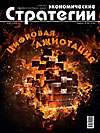Digital Agitation
Opening address of editor-in-chief.

Opening address of editor-in-chief.
A critical analysis of formation of the European Union — the most significant and mature international regional integration grouping — allows us to identify the sequence and maturing degree of various conditions of interaction, that is, to assess the time characteristics of integration and to identify its most significant stages, as well as to analyze the emerging contradictions and institutional problems of the EU.
The article considers the principle of diverse-speed integration, application experience, pluses and minuses, as well as its impact on development of existing regional associations.
The article considers duality of the globalization concept — as a process based on internationalization of the reproductive chain of the world GDP creation and as a policy pursuing and realizing the goal of forming and maintaining a monopolar global community; it is argued that economic content of globalization remains important for the present stage of the world community development; the article presents the arguments proving supportive measures taken by international organizations in order to support the process of cooperation and production specialization, restoration of balanced structures of national economies; arguments are given proving the monopoly insolvency, disavowing neoliberalism as a theory justifying this process; the author substantiates the principles determining formation of a multipolar world community and meeting the current realities of the world community development.
This article is concerned with decentralized network structures. Emphasis is placed on their matrix, i.e. the system of ideological attitudes, values, myths, behavioral norms, and tacit knowledge that is exemplified by software development techniques in the networks of IT specialists. The knowledge exists at the level of the whole network and is not completely accessible to each individual network member. The advent of digital technology is currently giving a new impetus to the development of decentralized cooperative structures. Of paramount importance are the mechanisms of non-hierarchical behavioral coordination that operate in network structures. Special attention is to be given to psychological techniques that secure the dominance of group-level goals, values and creative processes over the individual behavioral trends of network members. Such techniques that involve subconscious brain modules can be facilitated by regulatory social structures, referred to as social chaperons. Promoting the chaperons’ optimal functioning and enhancing their soft guiding and stimulating influence could be the mission of a novel social institutions including the Committee for Promotion of Network Structures, the Research Institute for Network Structures, state-supported counseling bodies for network developers, and public network associations. These innovative state-level bodies should aim to (i) legalize the status of decentralized cooperative network structures, (ii) optimize their organization and (iii) harmonize their interaction with non-network structures such as centralized hierarchies, including the “President’s vertical” power structure and local bureaucratic structures, as well as quasi-market structures.
Crisis processes in the economy are often presented as consequences of external factors, and not of inefficient state decisions. The authors of the article propose to consider the economy as a complicated multi-factor system, which should be influenced through state economic regulation. The forthcoming digital transformation of economic processes and immersion of all economic entities in the digital space bring both opportunities and threats for the Russian Federation. Digital images of subjects and digital traces of their interactions in the course of economic processes are beginning to acquire value, becoming digital assets. Using a platform approach in the economy at the state level, on the one hand, will ensure digital sovereignty of the country, and on the other hand it will allow to use digital assets as an accurate and operative information base for modeling economic processes that will provide quality and effectiveness of the state regulation.
The article suggests a scenario hypothesis of using geofinans in the format of crypto currency as one of the mechanisms for restructuring the economic space. The paper considers the process of transition from network self-organization to hierarchies with direct inclusion of professional and microterritorial economies, localized through crypto-currencies, into super-large international structures.